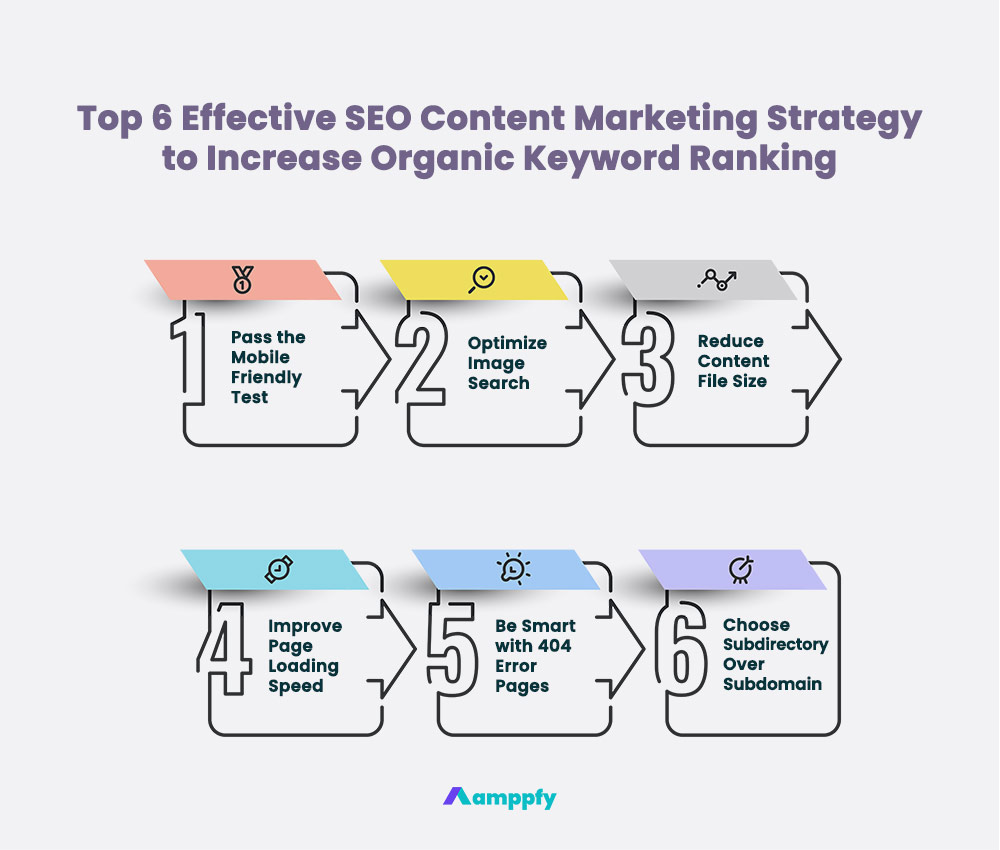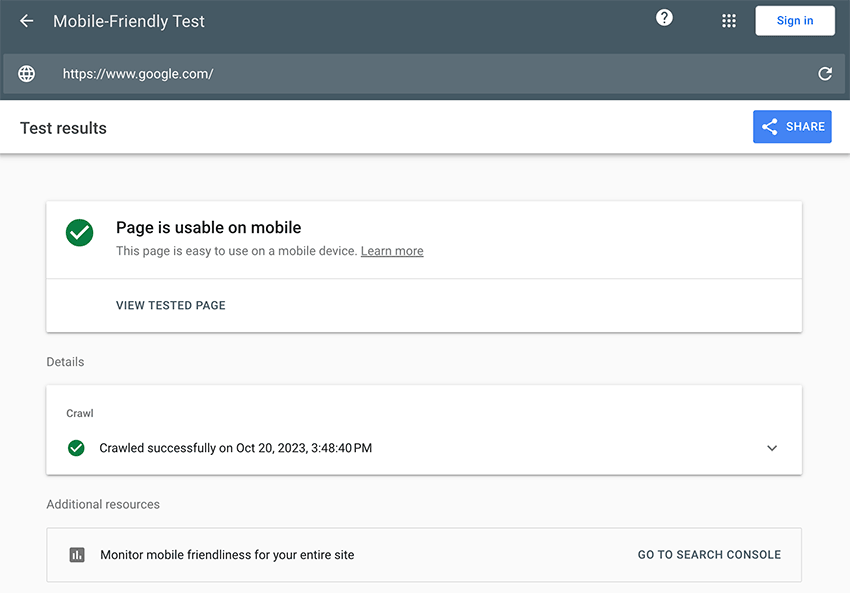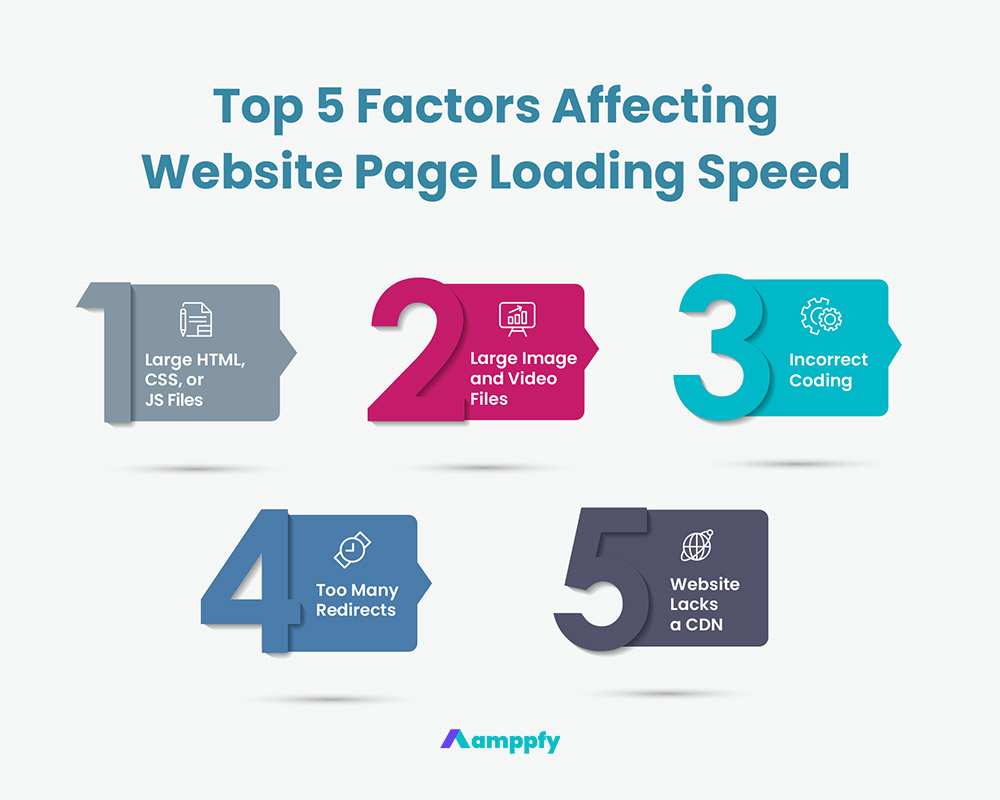Share via:

-
Save
Let’s discuss more advanced SEO content marketing implementation strategies to capture website ranking signals and score top positions in search results. Also, refer to our fundamental content marketing strategies to increase keyword ranking.
Top 6 Effective SEO Content Marketing Implementation Strategies to Increase Organic Keyword Ranking

-
Save
#1. Pass the Mobile-Friendly Test to Improve SEO Content Marketing on Mobile Devices
Google officially made mobile-friendliness a must-have as a website ranking signal. Webpages not passing the mobile-friendliness test will not appear in mobile search results.
Website Content Layout Affects Mobile-Friendliness
How content is laid out on a website affects how it displays on tablet and mobile devices. To be mobile-friendly, content should intuitively adapt to a mobile viewing port when visitors are on a mobile device. A mobile-friendly design is critical in properly delivering content on different displays.
Top 2 Mobile-Friendly Tests to Improve SEO Content Marketing
Test 1: How to Test Individual Webpages for Mobile-Friendliness?
To find out if a webpage is mobile-friendly, self-test individual webpages with Google Search Console mobile-friendly test tool.

-
Save
Test 2: How to Test the Entire Website for Mobile-Friendliness?
Log in to your Google Search Console account and check the entire website for mobile-friendliness with “Mobile Usability” in the Search Traffic tab.
Top 2 SEO Content Marketing Strategies to Optimize Website for Mobile Search
If your website is not yet mobile-friendly, how do you make the change? Here are the top two recommendations from Google.
Strategy 1: Update to Responsive Web Design
Choose a responsive web design that serves the same version of HTML codes on desktop, tablet, and mobile devices. The responsive design’s CSS (Cascading Style Sheet) codes render different displays to users on various devices.
Learn more about Google-recommended responsive web design.
Strategy 2: Implement Dynamic Serving
Implementing dynamic serving allows different sets of HTML to be shown on different viewing ports. The URL, however, remains the same.
#2. Optimize Image Search for SEO Content Marketing
Image search is another great way to capture organic traffic on search engines. This is especially useful if your business is an e-commerce or the website is image-heavy.
How to Get Your Website Show Up in Google Image Search?
To have your website show up in Google image search, Google needs to read the images. Follow the 2-step image optimization strategy below.
2-Step Image Optimization Guide to Improve SEO Content Marketing
Step 1: Use Keywords to Name Image Files
Search engines index keywords in image files. Using optimized keywords to name image files effectively increases a website’s exposure in search results. An optimized image file name should contain words that adequately describe the image content. Avoid uploading an image file with a random name like “IMG_02165.jpg” or “picture 1.png”.
Step 2: Include ALT Tags to Optimize Image Files for Search
Instead of inserting an image link as <img src=” image link”/>, try using ALT tags to optimize image files so they appear in search results. ALT Tags in image source code help search engines identify and index image content for image search, which is another effective strategy to gain organic traffic.
Example of an ALT Tag
<div class="ss-on-media-container"><span class="ss-on-media-image-wrap"><img class="ss-on-media-img" decoding="async" src=" image link" alt=" a brief and to the point description of the image with keywords"/> <div class="ss-on-media-wrapper ss-top-right-on-media ss-regular-icons ss-with-spacing ss-circle-icons">
<ul class="ss-social-icons-container ss-on-media-pinit">
<li>
<div data-ss-ss-link="https://pinterest.com/pin/create/button/?url=https%3A%2F%2Famppfy.com%2Fseo-content-marketing%2Fseo-content-marketing-implementation-strategy-guide%2F&media=%20image%20link&description=Let%27s%20discuss%20more%20advanced%20SEO%20content%20marketing%20implementation%20strategies%20to%20capture%20website%20ranking%20signals%20and%20score%20top%20positions%20in%20search%20results.%20Also%2C%20refer%20to%20our%20fundamental%20content%20marketing%20strategies%20to%20increase%20keyword%20ranking.Top%206%20Effective%20SEO%20Content%20Marketing%20Implementation%20Strategies%20to%20Increase%20Organic%20Keyword%20Ranking%09%09%09%09%09%09%09%09%09%09%09%09%09%09%09%09%09%09%09%09%09%09%09%09%09%09%09%09%09%09%231.%20Pass%20the%20Mobile-Friendly%20Test%C2%A0to%20Improve%20SEO%20Content%20Marketing%20on%20Mobile%20DevicesGoogle%20officially%20made%20mobile-friendliness%C2%A0a%20must-have%20as%20a%20website%20ranking%20signal.%20Webpages%20not%20passing%20the%20mobile-friendliness%20test%20will%20not%20appear%20in%20mobile%20search%20results.Website%20Content%20Layout%20Affects%20Mobile-FriendlinessHow%20content%20is%20laid%20out%20on%20a%20website%20affects%20how%20it%20displays%20on%20tablet%20and%20mobile%20devices.%20To%20be%20mobile-friendly%2C%20content%20should%20intuitively%20adapt%20to%20a%20mobile%20viewing%20port%20when%20visitors%20are%20on%20a%20mobile%20device.%20A%20mobile-friendly%20design%20is%20critical%20in%20properly%20delivering%20content%20on%20different%20displays.Top%202%20Mobile-Friendly%20Tests%20to%20Improve%20SEO%20Content%20MarketingTest%201%3A%20How%20to%20Test%20Individual%20Webpages%20for%20Mobile-Friendliness%3FTo%20find%20out%20if%20a%20webpage%20is%20mobile-friendly%2C%20self-test%20individual%20webpages%20with%C2%A0Google%20Search%20Console%20mobile-friendly%20test%20tool.%C2%A0%09%09%09%09%09%09%09%09%09%09%09%09%09%09%09%09%09%09%09%09%09%09%09%09%09%09%09%09%09%09Test%202%3A%20How%20to%20Test%20the%20Entire%20Website%20for%20Mobile-Friendliness%3FLog%20in%20to%C2%A0your%20Google%20Search%20Console%C2%A0account%20and%20check%20the%20entire%20website%20for%20mobile-friendliness%20with%20%22Mobile%20Usability%22%20in%20the%C2%A0Search%20Traffic%C2%A0tab.Top%202%20SEO%20Content%20Marketing%20Strategies%20to%20Optimize%20Website%20for%20Mobile%20Search%C2%A0If%20your%20website%20is%20not%20yet%20mobile-friendly%2C%20how%20do%20you%20make%20the%20change%3F%20Here%20are%20the%20top%20two%20recommendations%20from%20Google.Strategy%201%3A%20Update%20to%20Responsive%20Web%20DesignChoose%20a%20responsive%20web%20design%20that%20serves%20the%20same%20version%20of%20HTML%20codes%20on%20desktop%2C%20tablet%2C%20and%20mobile%20devices.%20The%20responsive%20design%27s%20CSS%20%28Cascading%20Style%20Sheet%29%20codes%20render%20different%20displays%20to%20users%20on%20various%20devices.Learn%20more%20about%C2%A0Google-recommended%20responsive%20web%20design.Strategy%202%3A%20Implement%20Dynamic%20ServingImplementing%20dynamic%20serving%20allows%20different%20sets%20of%20HTML%20to%20be%20shown%20on%20different%20viewing%20ports.%20The%20URL%2C%20however%2C%20remains%20the%20same.%232.%20Optimize%20Image%20Search%20for%20SEO%20Content%20MarketingImage%20search%20is%20another%20great%20way%20to%20capture%20organic%20traffic%20on%20search%20engines.%20This%20is%20especially%20useful%20if%20your%20business%20is%20an%20e-commerce%20or%20the%20website%20is%20image-heavy.%C2%A0How%20to%20Get%20Your%20Website%20Show%20Up%20in%20Google%20Image%20Search%3FTo%20have%20your%20website%20show%20up%20in%20Google%20image%20search%2C%20Google%20needs%20to%20read%20the%20images.%20Follow%20the%202-step%20image%20optimization%20strategy%20below.2-Step%20Image%20Optimization%20Guide%20to%20Improve%20SEO%20Content%20MarketingStep%201%3A%20Use%20Keywords%20to%20Name%20Image%20Files%C2%A0Search%20engines%20index%20keywords%20in%20image%20files.%20Using%20optimized%20keywords%20to%20name%20image%20files%20effectively%20increases%20a%20website%27s%20exposure%20in%20search%20results.%20An%20optimized%20image%20file%20name%20should%20contain%20words%20that%20adequately%20describe%20the%20image%20content.%20Avoid%20uploading%20an%20image%20file%20with%20a%20random%20name%20like%20%22IMG_02165.jpg%22%20or%20%22picture%201.png%22.%C2%A0Step%202%3A%C2%A0Include%20ALT%20Tags%20to%20Optimize%20Image%20Files%20for%20Search%C2%A0Instead%20of%20inserting%20an%20image%20link%20as%20%2C%20try%20using%20ALT%20tags%20to%20optimize%20image%20files%20so%20they%20appear%20in%20search%20results.%20ALT%20Tags%20in%20image%20source%20code%20help%20search%20engines%20identify%20and%20index%20image%20content%20for%20image%20search%2C%20which%20is%20another%20effective%20strategy%20to%20gain%20organic%20traffic.Example%20of%20an%20ALT%20Tag%09%09%09%09%09%09%09%09%09%09%09%09%09%09%09%09%09%09%09%09%09%09%093%20Good%20Practices%20for%20Creating%20ALT%20Tags%09%09%09%09%09%09%09%09Keep%20it%20simple%20and%20brief.Get%20to%20the%20point.Optimize%20ALT%20tags%20with%20keywords%2C%20but%20avoid%20keyword%20stuffing.%09%09%09%09%09%09%09%233.%20Reduce%20Content%20File%20Size%20to%20Increase%20Website%20Page%20Loading%20SpeedImages%20and%20videos%20are%20great%20visual%20content%20to%20boost%20visitor%20engagement.%20However%2C%20loading%20speed%20decreases%20for%20end-users%20when%20hundreds%20of%20pictures%20and%20videos%20are%20uploaded%20to%20a%20website.Learn%20more%20about%20website%20page%20loading%20speed%C2%A0and%20how%20it%20affects%20SEO.Large%20File%20Size%20Impacts%20Website%20Page%20Loading%20SpeedUser%20experience%20and%20conversion%20rate%20can%20suffer%20when%20a%20website%20takes%20too%20long%20to%20load%20due%20to%20large%20file%20sizes.%20It%20can%20increase%20the%20possibility%20of%20visitors%20leaving%20the%20website%20without%20taking%20action%2C%20resulting%20in%20high%20bounce%20rate.%20Ultimately%2C%20you%20could%20lose%20revenue%20because%20visitors%20are%20impatient%20and%20cannot%20wait%20for%20the%20website%20to%20finish%20loading.%20So%2C%20make%20sure%20the%20visual%20content%20files%20on%20the%20website%20are%20as%20small%20as%20possible%20without%20compromising%20too%20much%20on%20quality.Learn%20more%20about%20how%20to%20improve%20SEO%20content%20marketing%20with%20better%20user%20experience%20and%20readability.How%20to%20Reduce%20Image%20and%20Video%20File%20Sizes%20and%20Increase%20Page%20Loading%20SpeedReduce%20Image%20File%20SizesUse%20image%20tools%20like%20Adobe%20Photoshop%20to%20reduce%20file%20size%20and%20keep%20optimal%20image%20quality.%20Photoshop%20allows%20users%20to%20optimize%20images%20for%20web%20upload%20while%20providing%20the%20option%20to%20customize%20the%20file%20size%20and%20adjust%20image%20quality.%20The%20helpful%20feature%20enables%20users%20to%20quickly%20and%20effectively%20reduce%20image%20file%20size%20in%20a%20few%20clicks.%5Belementor-template%20id%3D%22977%22%5DLeverage%20Third-Party%20Video%20Hosting%20PlatformsHosting%20videos%20on%20a%20third-party%20platform%20such%20as%20YouTube%20significantly%20increases%20webpage%20loading%20speed%20compared%20to%20hosting%20videos%20on%20a%20website.%20Hosting%20videos%20through%20a%20third%20party%20does%20not%20take%20up%20bandwidth%20on%20your%20website%2C%20meaning%20website%20loading%20speed%20is%20unaffected.%20You%20can%20also%20receive%20free%20exposure%20from%20different%20marketing%20channels%20by%20sharing%20videos%20through%20YouTube.%234.%20Improve%20Page%20Loading%20Speed%20for%20Better%20SEO%20Content%20Marketing%20User%20ExperienceWebsite%20speed%20is%20imperative%20to%20SEO%20content%20marketing%2C%20as%20longer%20webpage%20loading%20time%20negatively%20impacts%20user%20experience.%20Website%20loading%20speed%20is%20also%20a%20vital%20Google%20algorithm%C2%A0and%20SEO%20ranking%20factor.%20If%20it%20takes%20longer%20for%20a%20webpage%20to%20load%20compared%20to%20an%20equivalent%20page%20from%20a%20competitor%2C%20the%20one%20with%20a%20slower%20loading%20speed%20loses%20out%20on%20higher%20ranking.%C2%A0Webpage%20loading%20speed%20has%20a%20lot%20to%20do%20with%20the%20content%20on%20a%20landing%20page%2C%20and%20there%20are%20a%20few%20critical%20reasons%20why%20a%20page%20takes%20too%20long%20to%20load.5%20Factors%20Affecting%20Website%20Page%20Loading%20Speed%09%09%09%09%09%09%09%09%09%09%09%09%09%09%09%09%09%09%09%09%09%09%09%09%09%09%09%09%09%09%09%09%09%09Large%20HTML%2C%20CSS%2C%20or%20Javascript%20files.Large%20image%20and%20video%20files.Any%20incorrectly%20coded%20on-page%20element.Too%20many%20redirects.The%20website%20lacks%20a%20Content%20Delivery%20Network%20%28CDN%29%20Service.%09%09%09%09%09%09%09How%20to%20Test%20for%20Webpage%20Loading%20SpeedTry%20using%20the%20free%20Google%20Pagespeed%20Insights%20to%20test%20webpage%20loading%20speed%20for%20desktop%20and%20mobile%20sites.%20The%20tool%20assigns%20a%20speed%20score%20out%20of%20100%2C%20showing%20you%20what%20on-page%20elements%20affect%20loading%20speed%20and%20should%20be%20fixed.%C2%A0%235.%20Be%20Smart%20with%20404%20Error%20Pages%22Oops%21%20The%20webpage%20you%20are%20looking%20for%20cannot%20be%20found%E2%80%A6%22Whether%20it%20is%20the%20result%20of%20a%20technical%20error%20or%20an%20unintentional%20mishap%2C%20404s%20are%20often%20perceived%20as%20a%20bad%20user%20experience.%20While%20it%20is%20not%20100%25%20preventable%2C%20there%20are%20things%20you%20can%20do%20to%20avoid%20the%20negative%20consequences%20of%20most%20404%20errors%20on%20a%20website.3%20Best%20404%20Page%20Strategies%20to%20Improve%20User%20Experience%09%09%09%09%09%09%09%09%09%09%09%09%09%09%09%09%09%09%09%09%09%09%09%09%09%09%09%09%09%09Strategy%201%3A%20Check%20for%20Broken%20LinksRegularly%20check%20URLs%20for%20broken%20links.%20Tools%20like%C2%A0Semrush%C2%A0identifies%20broken%20links%20on%20a%20website%20in%20a%20few%20clicks.%20On%20top%2C%20Semrush%20analyzes%20all%20the%20backlinks%20from%20%22Follow%22%20or%20%22NoFollow%22%20as%20well%20as%20text%20and%20image%20links.%5Belementor-template%20id%3D%22981%22%5DStrategy%202%3A%20Use%20301%20RedirectsUse%20301%20redirects%20to%20replace%20broken%20backlinks.%20While%20you%20can%20fix%20broken%20links%20manually%2C%20contacting%20website%20owners%20and%20asking%20them%20to%20replace%20all%20the%20broken%20backlinks%20pointing%20from%20their%20webpages%20to%20yours%20can%20be%20challenging%20and%20tedious.%C2%A0This%20is%20where%20the%20301%20redirects%20can%20be%20useful.%20If%20you%20have%20replaced%20or%20updated%20content%20on%20a%20website%20with%20new%20URLs%2C%20take%20the%20time%20to%20permanently%20redirect%20the%20old%20URLs%20to%20the%20new%20landing%20pages%20with%20301%20redirects.%20So%20that%20website%20traffic%20and%20user%20experience%20will%20not%20be%20negatively%20impacted%20by%20broken%20links.Strategy%203%3A%20Update%20404%20WebpagesTurn%20404%20errors%20into%20opportunities%20and%20capture%20more%20pageviews%20%E2%80%94%20design%20404%20pages%20with%20the%20intent%20to%20redirect%20visitors%20back%20to%20other%20working%20pages%20of%20the%20website.%20Include%20links%20to%20similar%20pages%20that%20might%20interest%20visitors%20if%20they%20stumble%20upon%20a%20non-working%20page.%20You%20can%20even%20promote%20a%20campaign%20to%20reduce%20the%20%22frown%20factor%22%20of%20a%20404%20error%20page.%236.%20Choose%20Subdirectory%20Instead%20of%20Subdomain%20for%20Blog%20PostsIf%20your%20website%20has%20an%20active%20blog%20section%2C%20subdirectory%20vs.%20subdomain%20is%20an%20important%20topic%20to%20consider.Examples%20of%20Subdirectory%20Versus%20Subdomain%09%09%09%09%09%09%09%09A%C2%A0subdirectory%C2%A0blog%20would%20be%20examplewebsite.com%2Fblog.%C2%A0A%C2%A0subdomain%C2%A0blog%20would%20be%20blog.examplewebsite.com.%09%09%09%09%09%09%09%5Belementor-template%20id%3D%22675%22%5DSubdirectory%20is%20Recommended%20for%20the%20Blog%20Section%20of%20a%20WebsitePlacing%20blogs%20under%20a%20subdirectory%20is%20recommended.%20When%20blogging%20content%20is%20under%20the%20same%20domain%20as%20other%20webpages%2C%20it%20allows%20%22link%20juice%2C%22%20or%20the%20internal%20link%20authority%2C%20to%20pass%20from%20a%20domain%20name%20to%20the%20blog%20subdirectory.Moz%2C%20a%20leading%20authority%20in%20the%20SEO%20industry%2C%20has%20provided%20a%20detailed%20case%20study%20about%20the%20use%20of%20subdomains%20versus%20subdirectories.%20The%20analysis%20is%20based%20on%20testing%20its%20own%20blog%20section%27s%20organic%20traffic.%20Moz%20chooses%20to%20have%20its%20blog%20fall%20under%20a%20subdirectory%20instead%20of%20a%20subdomain%20because%20the%20SEO%20ranking%C2%A0significantly%20improves%20when%20blogs%20are%20under%20a%20subdirectory.%5Belementor-template%20id%3D%221071%22%5D" class="ss-pinterest-color ss-pinit-button ss-ss-on-media-button" data-ss-ss-location="on_media" data-ss-ss-network-id="pinterest" data-ss-ss-type="share">
<span class="ss-on-media-content">
<svg class="ss-svg-icon" aria-hidden="true" role="img" focusable="false" width="32" height="32" viewBox="0 0 32 32" xmlns="http://www.w3.org/2000/svg"><path d="M10.625 12.25c0-1.375 0.313-2.5 1.063-3.438 0.688-0.938 1.563-1.438 2.563-1.438 0.813 0 1.438 0.25 1.875 0.813s0.688 1.25 0.688 2.063c0 0.5-0.125 1.125-0.313 1.813-0.188 0.75-0.375 1.625-0.688 2.563-0.313 1-0.563 1.75-0.688 2.313-0.25 1-0.063 1.875 0.563 2.625 0.625 0.688 1.438 1.063 2.438 1.063 1.75 0 3.188-1 4.313-2.938 1.125-2 1.688-4.375 1.688-7.188 0-2.125-0.688-3.875-2.063-5.25-1.375-1.313-3.313-2-5.813-2-2.813 0-5.063 0.875-6.75 2.688-1.75 1.75-2.625 3.875-2.625 6.375 0 1.5 0.438 2.75 1.25 3.75 0.313 0.313 0.375 0.688 0.313 1.063-0.125 0.313-0.25 0.813-0.375 1.5-0.063 0.25-0.188 0.438-0.375 0.5s-0.375 0.063-0.563 0c-1.313-0.563-2.25-1.438-2.938-2.75s-1-2.813-1-4.5c0-1.125 0.188-2.188 0.563-3.313s0.875-2.188 1.625-3.188c0.75-1.063 1.688-1.938 2.688-2.75 1.063-0.813 2.313-1.438 3.875-1.938 1.5-0.438 3.125-0.688 4.813-0.688 1.813 0 3.438 0.313 4.938 0.938 1.5 0.563 2.813 1.375 3.813 2.375 1.063 1.063 1.813 2.188 2.438 3.5 0.563 1.313 0.875 2.688 0.875 4.063 0 3.75-0.938 6.875-2.875 9.313-1.938 2.5-4.375 3.688-7.375 3.688-1 0-1.938-0.188-2.813-0.688-0.875-0.438-1.5-1-1.875-1.688-0.688 2.938-1.125 4.688-1.313 5.25-0.375 1.438-1.25 3.188-2.688 5.25h-1.313c-0.25-2.563-0.188-4.688 0.188-6.375l2.438-10.313c-0.375-0.813-0.563-1.813-0.563-3.063z"></path></svg>Save </span>
</div>
</li>
</ul>
</div>
</span></div>
3 Good Practices for Creating ALT Tags
- Keep it simple and brief.
- Get to the point.
- Optimize ALT tags with keywords, but avoid keyword stuffing.
#3. Reduce Content File Size to Increase Website Page Loading Speed
Images and videos are great visual content to boost visitor engagement. However, loading speed decreases for end-users when hundreds of pictures and videos are uploaded to a website.
Learn more about website page loading speed and how it affects SEO.
Large File Size Impacts Website Page Loading Speed
User experience and conversion rate can suffer when a website takes too long to load due to large file sizes. It can increase the possibility of visitors leaving the website without taking action, resulting in high bounce rate. Ultimately, you could lose revenue because visitors are impatient and cannot wait for the website to finish loading. So, make sure the visual content files on the website are as small as possible without compromising too much on quality.
Learn more about how to improve SEO content marketing with better user experience and readability.
How to Reduce Image and Video File Sizes and Increase Page Loading Speed
Reduce Image File Sizes
Use image tools like Adobe Photoshop to reduce file size and keep optimal image quality. Photoshop allows users to optimize images for web upload while providing the option to customize the file size and adjust image quality. The helpful feature enables users to quickly and effectively reduce image file size in a few clicks.

-
Save
Best for Creatives, Photography, Design, Video.
5.0 Amppfy Rating
- All-in-one creative suite of photography, video, design, and user experience tools.
- Help businesses create, source, and publish content across devices.
- Desktop and cloud applications such as Adobe Photoshop, InDesign, Premiere Rush, Illustrator, and much more.
- Access to Adobe stock images, videos, and audio files.
- Because the software is cloud-based, you will always receive the latest updated version at no additional cost.
- One low monthly price to use 20+ Creative Cloud apps.
- Adobe Creative Suite is the industry-standard design application bundle for graphics, visuals, and videography.
Adobe
Creative Cloud has the design tools to bring your ideas to life, with apps for everything from image compositing and photo editing to website design, digital painting, 3D, and augmented reality.-
All-in-one creative suite of photography, video, and design
-
Help businesses create, source, and publish content across devices
-
Apps such as Photoshop, InDesign, Premiere Rush, Illustrator
-
Access to Adobe stock images, videos, and audio files
Leverage Third-Party Video Hosting Platforms
Hosting videos on a third-party platform such as YouTube significantly increases webpage loading speed compared to hosting videos on a website. Hosting videos through a third party does not take up bandwidth on your website, meaning website loading speed is unaffected. You can also receive free exposure from different marketing channels by sharing videos through YouTube.
#4. Improve Page Loading Speed for Better SEO Content Marketing User Experience
Website speed is imperative to SEO content marketing, as longer webpage loading time negatively impacts user experience. Website loading speed is also a vital Google algorithm and SEO ranking factor. If it takes longer for a webpage to load compared to an equivalent page from a competitor, the one with a slower loading speed loses out on higher ranking.
Webpage loading speed has a lot to do with the content on a landing page, and there are a few critical reasons why a page takes too long to load.
5 Factors Affecting Website Page Loading Speed

-
Save
- Large HTML, CSS, or Javascript files.
- Large image and video files.
- Any incorrectly coded on-page element.
- Too many redirects.
- The website lacks a Content Delivery Network (CDN) Service.
How to Test for Webpage Loading Speed
Try using the free Google Pagespeed Insights to test webpage loading speed for desktop and mobile sites. The tool assigns a speed score out of 100, showing you what on-page elements affect loading speed and should be fixed.
#5. Be Smart with 404 Error Pages
“Oops! The webpage you are looking for cannot be found…”
Whether it is the result of a technical error or an unintentional mishap, 404s are often perceived as a bad user experience. While it is not 100% preventable, there are things you can do to avoid the negative consequences of most 404 errors on a website.
3 Best 404 Page Strategies to Improve User Experience

-
Save
Strategy 1: Check for Broken Links
Regularly check URLs for broken links. Tools like Semrush identifies broken links on a website in a few clicks. On top, Semrush analyzes all the backlinks from “Follow” or “NoFollow” as well as text and image links.

-
Save
Best for SEO Marketing.
5.0 Amppfy Rating
- Discover all the best keywords to target and bring traffic to a website through Semrush keyword research tool.
- Audit webpages and suggest ideas to improve landing page health and SEO performance.
- Optimize a website for local searches to increase local customer traffic.
- Track daily changes of keywords important to marketing.
- Find unexploited opportunities to strengthen website backlink profile.
- Uncover all the keywords and content in competitors’ SEO strategies.
- Track hundreds of relevant keywords and their Google rankings on a daily basis.
- Easily research keywords that have search volume relevant to any blog or website.
- Page-by-page SEO analysis to consistently improve organic SEO rankings.
Semrush
SEO, PPC, and research tools.-
5 projects
-
500 keywords to track
-
10,000 results per report
Strategy 2: Use 301 Redirects
Use 301 redirects to replace broken backlinks. While you can fix broken links manually, contacting website owners and asking them to replace all the broken backlinks pointing from their webpages to yours can be challenging and tedious.
This is where the 301 redirects can be useful. If you have replaced or updated content on a website with new URLs, take the time to permanently redirect the old URLs to the new landing pages with 301 redirects. So that website traffic and user experience will not be negatively impacted by broken links.
Strategy 3: Update 404 Webpages
Turn 404 errors into opportunities and capture more pageviews — design 404 pages with the intent to redirect visitors back to other working pages of the website. Include links to similar pages that might interest visitors if they stumble upon a non-working page. You can even promote a campaign to reduce the “frown factor” of a 404 error page.
#6. Choose Subdirectory Instead of Subdomain for Blog Posts
If your website has an active blog section, subdirectory vs. subdomain is an important topic to consider.
Examples of Subdirectory Versus Subdomain
- A subdirectory blog would be examplewebsite.com/blog.
- A subdomain blog would be blog.examplewebsite.com.
Subdirectory is Recommended for the Blog Section of a Website
Placing blogs under a subdirectory is recommended. When blogging content is under the same domain as other webpages, it allows “link juice,” or the internal link authority, to pass from a domain name to the blog subdirectory.
Moz, a leading authority in the SEO industry, has provided a detailed case study about the use of subdomains versus subdirectories. The analysis is based on testing its own blog section’s organic traffic. Moz chooses to have its blog fall under a subdirectory instead of a subdomain because the SEO ranking significantly improves when blogs are under a subdirectory.
Continue the Learning Journey with Amppfy
Amppfy’s digital marketing resource library is beginner-friendly, and zero technical or marketing experience is required to get started. Learn how to create a practical, actionable, and programmatic digital marketing playbook for any business website, e-commerce store, or content platform. Leverage effective SEO, SEM, and social media strategies to boost brand authority, increase online visibility, and generate quality demand.
Follow us on LinkedIn, Facebook, Instagram, and YouTube to stay updated on the latest marketing news, strategies, and free content.
Get Started with Free Generative AI Marketing Tools
- 100% Free
- No Account Required
- Available 24/7





